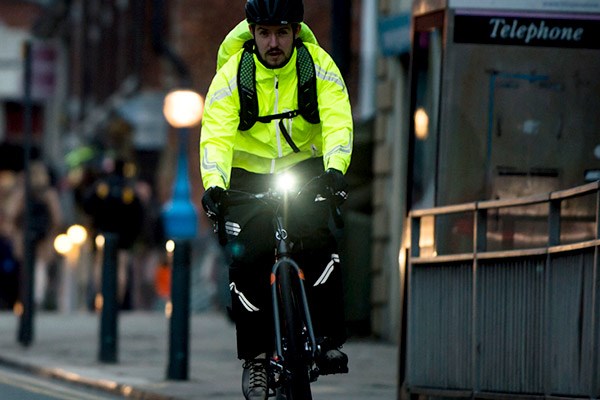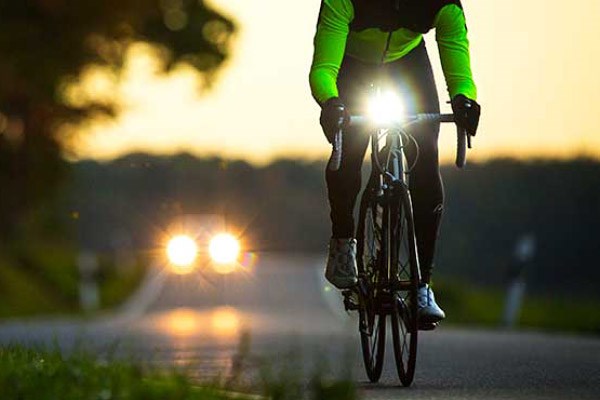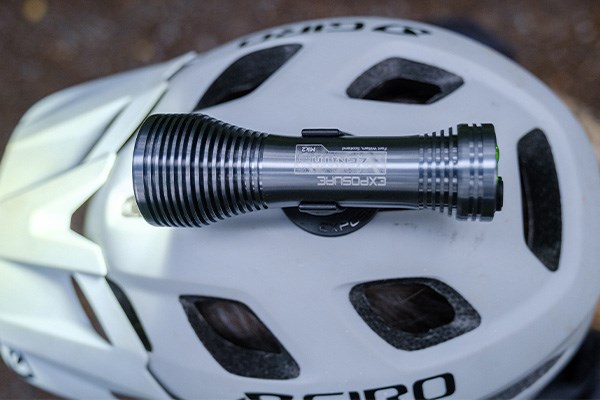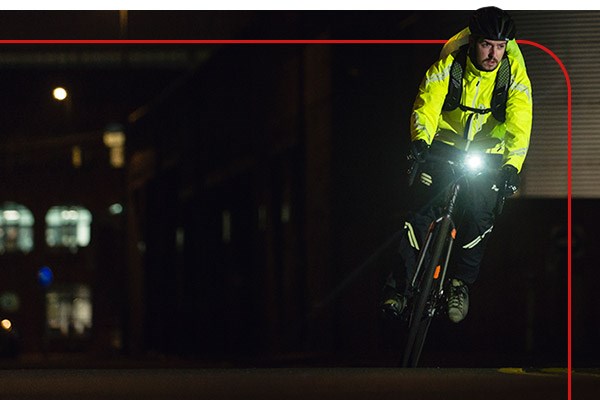Whether you like to ride the open road, shred the trails or cruise through the urban jungle you don’t need to let the dark stop you from riding all year round. Modern bike lights are bright and compact, so you can see and be seen wherever you cycle through the dark.
Most bike lights use bright and efficient LEDs for illumination. The lens will either spread the light so it can be seen from many angles or concentrate the light into a beam to show the way ahead. Most modern front lights use Lithium-ion batteries that give long burn times for a relatively short charge time. Most lights have different modes to control brightness and/or flashes.
As you'd expect, the more you spend on lights the brighter they tend to be. Measured in Lumens, brightness varies from small back-up LED flashers, to off-road lights with thousands of lumens to rival the brightness of car headlights.
In this bike lights guide we’ll look at all the different types of lights, those to see and those to be seen, and which style of cycling they are best suited to.

Best Cycling Lights
Here is our pick of the best bike lights for being seen when cycling on the road and seeing where you're going when riding off-road trails and dark roads.
Best Lights to See

When it's completely dark you'll need a good set of lights to see where you're going. This is our pick of the best lights for mountain bike, gravel and road night riding.
See and be Seen – Road & Commuter Lights
If you are cycling on the road after dark you should have both a front and rear light on your bike. When cycling on roads that are lit by streetlights then you only need lights to be seen by. However, if you are cycling on unlit roads then you will also need a front light that is powerful enough to illuminate the road ahead of you.
Urban Cycling
If you commute on lit-up city streets, you will need lights to be seen, rather than to see by.
A front light with around 100 lumens should be enough for city commuting, with around 30 lumens for the rear. If you live in a darker area add lumens to your front light requirements up to around 800 for a totally dark cycle path.
Flashing lights can enhance your visibility especially on the rear. It is usually a good idea to have at least one of your rear lights set to flashing mode as this will help you to be seen more easily.

Popular Rear Lights
The more lights you have, the more visible you will be to traffic, so ideally you should have more than one light at each end at different heights. For instance, attach the main light to your seatpost and have a backup light on the rear of your helmet or backpack.
Buying a light set usually works out cheaper than purchasing front and rear lights individually.
It's a great way to get a pair of backup lights or a more substantial pair of main lights. What's more, you'll have a coordinated look to your bike. Usually, the more powerful lights are only available individually but when you need a pair to be seen, especially for urban riding, a set is a great choice.

Popular commuter light sets
Cycling on Unlit Roads
When cycling on unlit roads you will need to increase the brightness of your lights. A front light that puts out 800 lumens or more is ideal. This will throw out a substantial beam that is bright enough to light your way and can also be seem easily be oncoming traffic. When riding with a powerful front light take care not to position the beam too high as you don’t want to dazzle drivers or other cyclists heading towards you.
Rear lights need to be more powerful too, especially if traffic is fast moving as they will need to spot you from further away. Look for rear lights that put out at least 50 lumens when cycling on unlit roads. Having two lights with one of them set to flashing mode is ideal.

Popular Front Lights for road cycling
Illuminate the Trail - Mountain Bike Lights
The most powerful bike lights are made for mountain bike night riding. This is because you need to see all the obstacles on the trail clearly some way ahead of you. A combination of a bar mounted light and a helmet light provides the best trail illumination.
While you don’t need the most powerful lights ever made to experience the thrill of off-road night riding, light is the main limiting factor to your speed on the trail. The more light you have the further you can see and the faster you can ride. This is why some of the best MTB lights put out more than 3,000 lumens.
Bar Mounted MTB lights
The main source of light when night riding will be from a handlebar mounted light with a beam pattern that shines far ahead, so that you can anticipate what’s ahead of you on the trail. While lumens are important here the quality of the beam pattern makes a big difference too. Ideally you want an even spread of light, so you can see the whole trail ahead and not just one spot.
Mountain bike lights also need to be tough and waterproof to cope with the rigours of riding through the depths of a UK winter. Variable light modes allow you to manage the battery life by dimming the light for fire roads and turning it up for tight wooded sections. The technology of MTB lights has moved fast in recent years and there are now lights that will automatically brighten as you speed up, to shine further ahead, and then dim again to save the battery when you slow down or stop.

Helmet Lights
When night riding you soon learn that you don’t always look where your front wheel pointing. A helmet light allows you to see around corners. This is especially useful in tight wooded sections as well as those long sweeping berms where your main light isn’t pointing where you are going.
You don’t want to add too much weight to your head, so the best helmet lights are small, compact, lightweight units. Mounts attach easily to your helmet and can be adjusted to fine tune the beam angle. Helmet lights often come with bar mounts as well so they can enhance your road or commuter bike set up too.

Popular MTB lights
Frequently Asked Questions
Yes. In the UK the law requires that you must have at least one white front light and one red rear light on your bike when cycling on the road between the hours of sunset and sunrise. The lights should be positioned up to 150cm from the ground. Reflectors at each end of your bike and on your pedals are also required.
Yes. Flashing lights, front and rear, meet the UK legal requirement if they flash between 60 and 240 times a minute and emit at least four candelas (a measure of luminous intensity easily exceeded by most bike lights today).
Yes, it seems that flashing bike lights are a little safer. A recent study showed that a flashing rear light makes cyclists more visible to drivers compared to an always on light. There is no evidence that a flashing front light makes you more visible than an always on bike light. We think that the safest option is to have both a steady beam and a flashing light on your bike.
In the UK the law requires bike lights to be positioned up to 150cm from the ground. The best place for a front light is on the handlebars. The seat post, saddle bag or rear luggage rack is the best place for a rear light.
This depends where you are riding. For unlit roads you will want a front light that is over 600 lumens to see properly ahead of you. A rear light that puts out more than 50 lumens is ideal too. If you use powerful front lights take care to point them low so that you don’t dazzle oncoming traffic.
Daylight running lights have been shown to reduce accident in cars, so it can be assumed that the same is true for bikes. We think that using lights during the day is especially important on dull rainy days. Wearing bright or high viz clothing helps you to be seen too.
Bike lights with lithium ion batteries take 2 - 4 hours to charge fully from flat. About 80% of the charge is usually completed in half the time, so you can use them again with just a quick booster charge.








